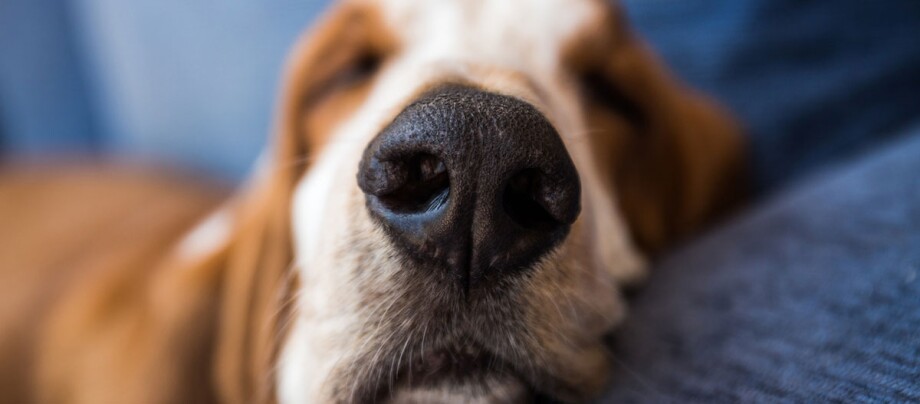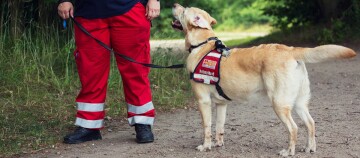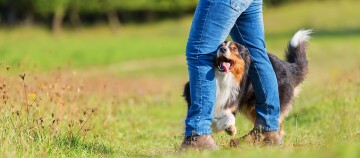Nose Work for the Dog – Step-by-Step to Becoming a Smelling Pro
07.10.2022 - Reading time: 5 minutes

With nosework you keep your dog busy according to its natural talent. Dogs are true olfactory specialists with a much higher sensitivity and discrimination ability in their nose. But this talent of the dog must be encouraged so that it can develop. Start introducing your dog to nosework step by step and turn it into a smelling pro. Read here what tips for nosework and search games you can practise with your dog!
Always follow your nose – nosework for a dog
When it comes to sense of smell, dogs are vastly superior to humans: we only have about five million olfactory cells. Dogs, on the other hand, have between about 125 million (dachshund) and 220 million (sheepdog) olfactory cells, depending on the breed. They are considered to be nasal animals (so-called macrosmata, Greek: “great smellers”). The area of the brain in which odours are processed is also significantly larger in our four-legged friends than in us humans. Dogs are able to distinguish in which nostril an odour is perceived more intensively, for example, in order to locate directions where an odour source is located. In this way, dogs can create something like “odour maps” of their surroundings in their minds. And they are able to focus on certain smells on this imaginary map. The ability to distinguish smells is a good 1,000 times higher in dogs than in humans.
Animal fun at work – encouraging nosework
All this shows how important (and breed-appropriate) it is to keep our dogs busy with nosework. It challenges dogs and is strenuous (in a positive sense), i.e. real work for our four-legged friends, who nowadays usually do not have to perform any other tasks. Nosework keeps them busy and promotes their ability to concentrate. Nosework is suitable for all dog breeds and ages – regardless of whether they are puppies or seniors.
It is always exciting to see what dogs are capable of with their sense of smell. After a few hours of training, almost every four-legged friend is capable of finding a hidden object or following a human for a kilometre on a scent trail. Special courses by dog trainers and books on the subject show you how to turn your dog into a true scent professional.
Everyday work – nosework during daily walks
Nosework is a perfect activity for dogs. Searching for small pieces of food or treats is a good way for beginners to learn. First, train the dog to pay attention to you with the command “Look here!” Then show the dog the treat and throw it into the meadow or along the path. Only when you give the command “Search!” can the dog run off to look for the treat. Alternatively, you can use your dog’s favourite toy, as too many snacks will make them fat. Or reduce the amount of food you give them accordingly.
In bad weather, simple nosework can also keep the dog busy at home or in the office. Increase the difficulty over time: hide the treat on a low branch of a tree, in a bush or on a rock.
Now the dog will learn to search in three-dimensional space. Vary your hiding places, because your dog will quickly learn where your special “favourite hiding places” are. To start with, always use the same dry food or treat and train the dog to run to search only on your signal. This will prevent your dog from sniffing around for food scraps all the time.
Detective games – your little Sherlock Holmes will find everything
Balls, toys, lost objects or money lying around: with a little practice, your dog will be able to distinguish between smells and (re)find certain objects. Start with your dog’s favourite toy. Drop it unnoticed and call your dog to you after a few steps. On the command “Where’s the ball?”, for example, it should look for its ball and get a treat as a reward when it has found it.
The game can be made more difficult with new objects, for example your key ring, a scarf or a T-shirt. Show the object to your dog and let it smell it. Then hide it and give the command to search. You will see that your dog will become more skilled over time, find the items faster and also find tricky hiding places.
Another variation can be introduced with the help of different smelling tea bags: several tea bags are hidden and the dog has to find the “right” tea bag that you have held under its nose. Only if the dog finds the right tea bag and brings it back or shows it, will it get the reward it was hoping for. You might be surprised, but your dog can also find different money. Simply because it smells different! Please make sure that you do not use objects that the dog can swallow and possibly choke on.
Always exercise in moderation and with enough water
Nosework is very strenuous for dogs. Make sure your dog has access to fresh water, because the mucous membranes of the nose dry out quickly during the search games. During nosework, your dog will breathe in and out up to 300 times per minute. It loses a lot of water through panting and sniffing. After a good ten minutes of intensive training, untrained dogs are completely out of breath. No wonder, after all, they are performing at their physical and mental best. Trained dogs or even such professionals as search, drug or avalanche dogs, are able to work for several hours.
Would you like to deepen your knowledge of nosework with your dog? Then take your four-legged friend on tracking expeditions. We have put together some tips for you in our guidebook “Tracking work”.


